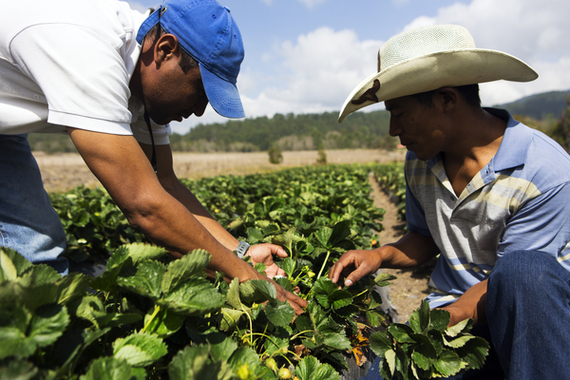For more than 1.7 million Hondurans surviving on less than US$1.25 per day is a reality. Honduras is in the second poorest region in Latin America and many of the poorest families live in rural areas where farming is the main source of income and survival. If we can find ways to improve farming incomes, then we can also lift people out of poverty.
Cecilia Mejía Dominguez, a small-scale farmer living in the mountains of western Honduras that we met this year, is a great example of how improved agricultural practices can lead directly to higher yields and a better life.
Cecilia used to grow basic foods and because her yields were low she lived below the poverty line, unable to provide for her four children. But in 2011, her life began to change. A USAID funded project - ACCESO - in partnership with CropLife Latin America, delivered training so farmers like Cecilia could get a great deal more from their land. She started growing high value crops, like strawberries, and she tripled her maize yield.
Fighting pests, caring for the environment
A key component of CropLife Latin America's involvement in the ACCESO project was to provide our crop protection experts and educational materials to train over 120 USAID field officers in good agricultural practices and the best ways to deal with crop pests and diseases. Under our guidance, these field officers were then able to go into the field to teach Cecilia and 30,000 other farmers on integrated pest management techniques such as how to monitor their crops, identify pests, and choose the best approach to tackle them. If this meant using crop protection products, the farmers were shown the safest way to administer them, including the right dose and timing.
Pests and diseases had always been a real issue for Cecilia and other farmers in the area, and the ability to protect them made a massive difference. A centre to collect pesticide containers and dispose of them safely was also established, to protect the environment from excess waste.
Boosting incomes with a multiplier effect
The project has also encouraged farmers to focus on crops that will boost their incomes, such as strawberries. Common crops like maize and beans can only generate around US$750 per hectare per year but high-value horticulture production with basic technologies and skilled crop protection techniques can generate around US$4,000 per hectare. Access to crop protection products and the knowledge to use them on these high value crops has helped many farmers significantly increase their income.
The approach of "training the trainers" has a multiplier effect that changes the behaviour of whole communities. One farmer will pass her knowledge on to the next. Then, once above the poverty line, farmers are able to become entrepreneurs and continually improve their standard of living
Partnering with the private sector to bring training to the masses
At CropLife Latin America we think public private partnerships like this are vital to tackling poverty in rural areas. We have the skills and expertise in crop protection, while USAID has the infrastructure and resources to deliver training on the ground on a large scale. With public investment in agricultural extension under pressure in Honduras, the private sector is ideally placed to join with development organisations such as USAID to help fill the gap. We believe public private partnerships will need to play a key role in tackling the United Nations Sustainable Development Goals that aim to end hunger and extreme poverty by 2030.
Other interventions in the USAID-ACCESO project included household visits from health technicians, training on nutrient-rich food production and preparation as well as forming links to markets to sell extra products at a better, more consistent price.
Overall, the ACCESO project has yielded some outstanding results. The total cropped area that received project assistance was just under 75,000 hectares and between 2013 and 2014 farm sales from basic grains and horticulture increased by US$50 million. Increased yields and sales have helped over 6,000 families move above the line of extreme poverty and 2,000 families nearly doubled their incomes from $1.25 to $2.42/person/day.
For farmers like Cecilia, getting technical advice, and access to the tools and technologies she needs, can be the difference between a life in poverty or of prosperity. Through strategic partnerships and training, farmers like Cecilia are now seeing a better future for their children.
Click here to read more Honduran farmer success stories.
